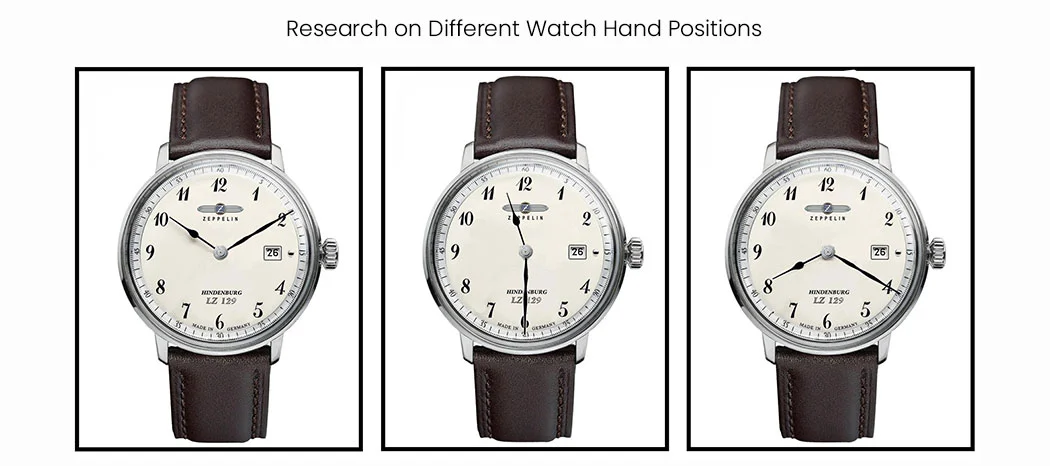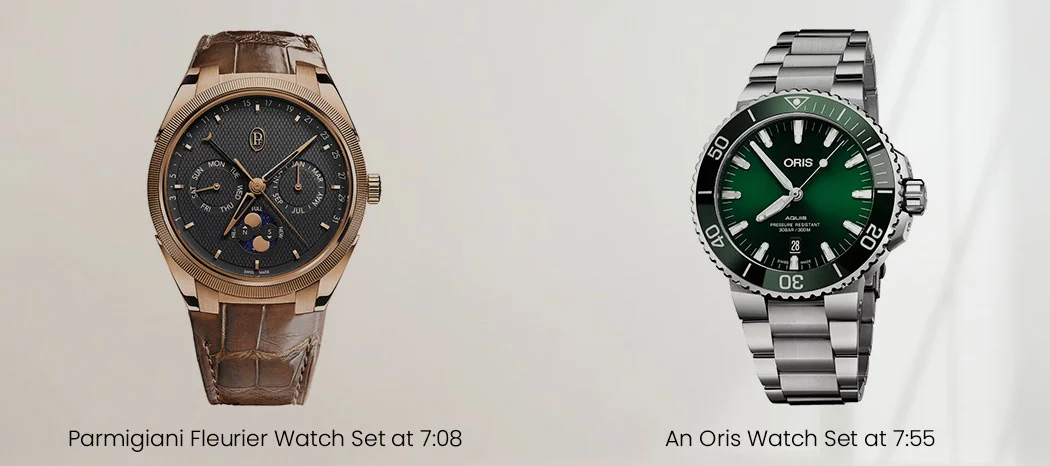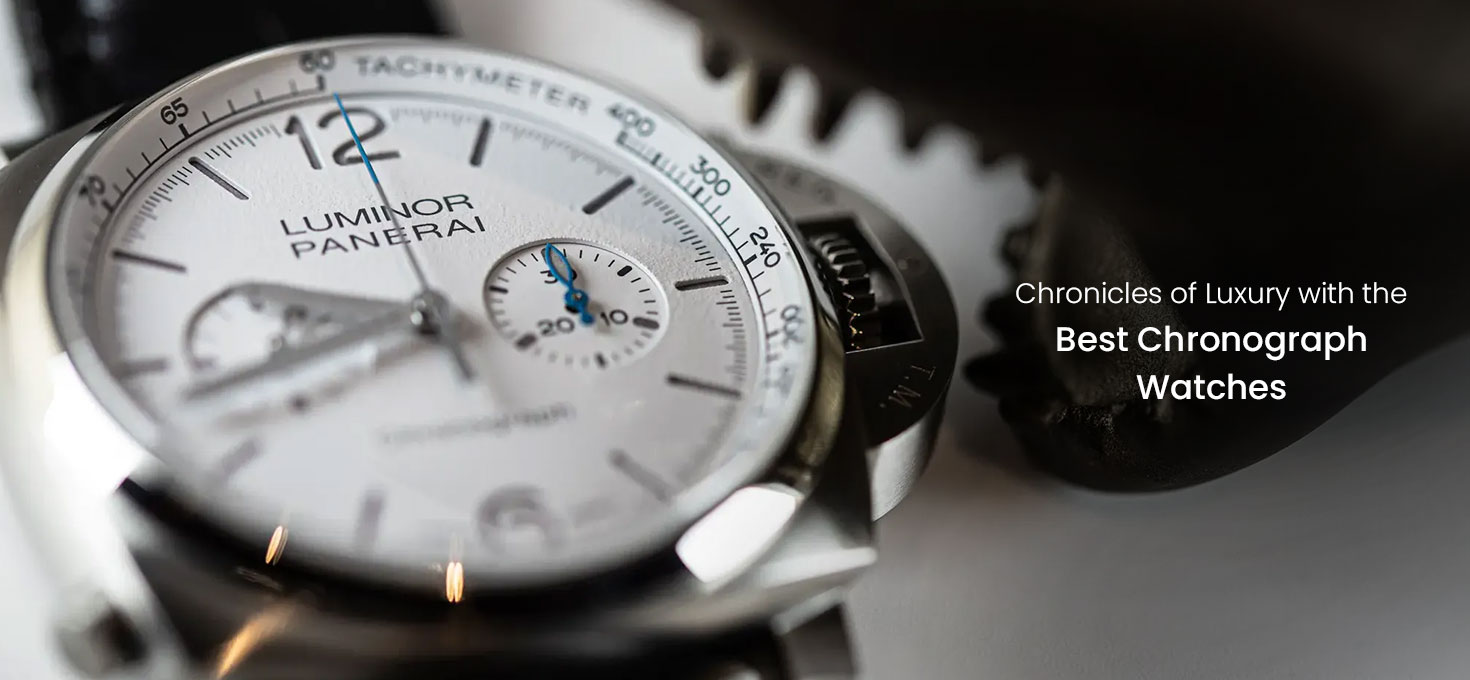 Reading Time: 6 minutes
Reading Time: 6 minutes
Step into any luxury watch store, and you’ll be greeted by a symphony of timepieces, all seemingly frozen in a moment of synchronized serenity. But look closer, and you’ll notice a recurring theme – the hands invariably point to 10:10. Ever wondered why most watches are set at 10:10? It’s not just a coincidence or a random choice—it’s a carefully orchestrated practice. This time setting has piqued curiosity and sparked various theories over the years. From historical anecdotes to practical considerations, the reasons behind this practice are multifaceted and intriguing.
Beyond its practicality, setting watches at 10:10 holds a deeper significance in the world of horology.
Popular Myths

The ubiquitous setting of watches to 10:10 has become a fascinating quirk in the world of horology, and over the years, it’s fueled a fair share of speculation. Some myths as to why most watches are set at 10:10 hold a certain romantic charm, while others delve into the realm of historical significance.
Claims that the first clock, invented around 300 BC, displayed this time are demonstrably false. The practice of setting watch hands at 10:10 likely originated in the 1920s and only became the industry standard in the 1950s. This debunks the romantic notion of a timeless tradition and instead highlights the strategic use of this time display in modern marketing and design. Another popular theory suggests 10:10 marks a pivotal moment in watchmaking history, perhaps the death of a famous watchmaker or a groundbreaking invention. However, watchmakers themselves have debunked this.
Beyond Telling Time: Why are most watches set at 10:10?
Interestingly, the connection between watch displays and consumer psychology seems to be a more recent discovery. In 2017, a study titled “Why Is 10 Past 10 the Default Setting for Watches and Watches in Advertisements? A Psychological Experiment” was published in Frontiers in Psychology. This research shed light on the surprising impact of time display on our perception. The study found that watches set at 10:10 triggered a significantly more positive emotional response in observers, which in turn, influenced their buying intention. Conversely, watches displayed at 8:20, the previous industry standard, had no noticeable effect on either emotions or purchase decisions. This suggests that the simple reason to why most watches are set at 10:10 might hold a subtle persuasive power, making the timepiece appear more appealing and desirable to potential buyers. It seems the watch industry has learned that a subtle smile can go a long way in making a timepiece more appealing.
While the scientific community might not endorse it, another widely held belief surrounding the 10:10 watch setting is rooted in numerology. This system assigns meaning to numbers and their arrangements. Numerology believers interpret seeing the 10:10 pattern repeatedly as a positive sign from the universe, signifying impending happiness, fulfillment of desires, and the arrival of good fortune. Furthermore, some angelic interpretations associate the 10:00 to 10:20 time frame with the angel Lecabel, a celestial being said to bring success, protection, and even offer assistance in artistic endeavors and technical matters. So, the next time you glance at your watch and see 10:10, it might not just be the time – it could be a message from the universe, according to these widespread theories.
The Actual Reasons Science behind the Hands Being Set at 10:10

While the primary purpose of a watch is undoubtedly to tell time, the seemingly arbitrary setting of the hands at 10:10 displays holds a deeper significance. This goes beyond mere aesthetics; it’s a strategic choice that enhances the watch’s visual appeal, optimizes readability and brand name visibility in most cases., Setting watches to 10:10 offers several practical benefits that contribute to the overall appeal and marketability of the timepiece: Let’s delve into the fascinating reasons why the 10:10 setting has become an enduring practice in the world of horology.
Aesthetics: Placing the hands at 10:10 frames the brand logo and other features on the watch face, creating a symmetrical and balanced appearance. This arrangement highlights the design elements of the watch, making it visually appealing to potential buyers.
Avoiding Obstructions: Placing the hands at 10:10 avoids covering important features such as the date window or chronograph subdials, which may be positioned at the lower part of the dial. By positioning the hands at 10:10, the watchmaker ensures that the hands do not overlap with other dial features. This enhances the clarity and readability of the watch face, allowing customers to easily discern the time and additional functions.
Showcasing the Brand: The 10:10 position frames the manufacturer’s logo located typically at the top of the watch face, ensuring it stands out prominently.
Exceptions to the Rule: Watch Hands to Reflect the Changing Trends

Marketing, the silent conductor of our desires, weaves its magic into nearly every aspect of our lives. From the clothes we wear to the food we crave, it shapes our perceptions and influences our choices. Even the seemingly innocuous world of timekeeping hasn’t escaped its grasp. Take the ubiquitous setting of watch hands at 10:10 –a setting that has become a ubiquitous symbol in watch, offering a multitude of benefits for showcasing timepieces. However, within the vast landscape of horology, brands may strategically deviate from this norm, and some brands like Oris, Parmigiani Fleurier, etc have already taken the route. Their choice to display watches at alternative times, such as 8:20 or 07:08, reflects a thoughtful approach to visual communication.
And as marketing needs evolve over time, the future could see a world where 10:10 remains the classic choice, while innovative brands experiment with alternative times, creating a captivating dance between tradition and the ever-shifting tides of consumer preference. This happens mainly for two reasons:
Firstly, it fosters brand differentiation. Imagine a meticulously crafted chronograph displayed at 8:20, with the hands strategically positioned to frame the chronograph subdials. This subtle deviation becomes a silent statement, emphasizing the watch’s functionality and intricate details. Conversely, a dress watch set at 11:50 exudes a timeless elegance, the hands drawing attention to the clean lines and minimalist design.
Secondly, these deviations from the standard can be seen as a testament to a brand’s innovative spirit. By consciously choosing an alternative time display, they demonstrate a willingness to push boundaries and experiment with established conventions. It becomes a mark of individuality, a subtle nod to the brand’s unwavering confidence in its design philosophy. Therefore, the next time you encounter a watch that doesn’t subscribe to the 10:10 tradition, consider it an invitation to explore further. It might just be a glimpse into the unique creative vision of a brand, waiting to be discovered.
In conclusion, the seemingly arbitrary answer to why most watches are set at 10:10 transcends mere aesthetics. This tradition whispers tales of meticulous design choices, ensuring every element – from the logo’s placement to the avoidance of dial obstruction – contributes to a visually balanced masterpiece. But the story doesn’t end there. A touch of marketing magic peeks through the hands, subtly influencing our perception and forging a connection with the timepiece. Ultimately, the 10:10 setting serves as a reminder that a watch is more than just a tool for telling time; it’s a carefully crafted statement piece, a marriage of form and function that continues to enthral watch aficionados the world over.
KAPOOR WATCH COMPANY:
For decades, Kapoor Watch Company has been synonymous with exquisite timekeeping. Step into our world and discover an unparalleled selection. Whether you seek the timeless elegance of Cartier, the rich heritage of Omega, or the innovative spirit of Breitling, we have a watch that speaks to your discerning taste. Our collection extends beyond iconic names, encompassing a vast array of options. At Kapoor Watch Company, we believe that a watch is more than just a timepiece; it’s a statement piece, a reflection of your personality and passion. Visit Kapoor Watch Co. website or Visit Kapoor Watch Co. Stores and embark on a journey through the world of luxury timekeeping, where you’ll find the perfect watch to tell not just time, but your story.
The post Hands Up at 10:10: A History Lesson on Watch Displays appeared first on Kapoor Watch Co. | Blogs.



